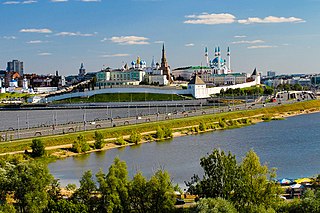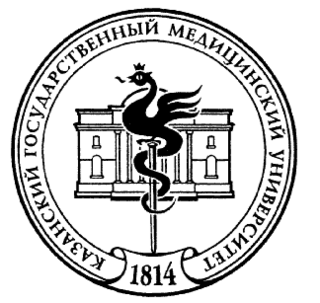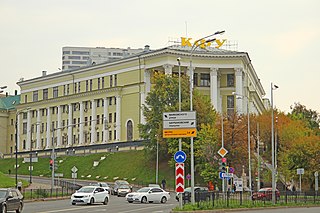

The National Library of the Republic of Tatarstan is the main state book depository in Tatarstan for national, republican, Russian and foreign publications. The library is located in Kazan, the capital of Tatarstan.


The National Library of the Republic of Tatarstan is the main state book depository in Tatarstan for national, republican, Russian and foreign publications. The library is located in Kazan, the capital of Tatarstan.

Tatarstan, officially the Republic of Tatarstan, sometimes also called Tataria, is a republic of the Russian Federation, located in Eastern Europe. It is a part of the Volga Federal District; and its capital and largest city is Kazan, an important cultural centre in Russia. The region's main source of wealth is oil with a strong petrochemical industry.

The Khanate of Kazan was a medieval Tatar Turkic state that occupied the territory of former Volga Bulgaria between 1438 and 1552. The khanate covered contemporary Tatarstan, Mari El, Chuvashia, Mordovia, and parts of Udmurtia and Bashkortostan; its capital was the city of Kazan. It was one of the successor states of the Golden Horde, and it came to an end when it was conquered by the Tsardom of Russia.

The Kazan Kremlin is the chief historic citadel of Russia, situated in the city of Kazan. It was built at the behest of Ivan the Terrible on the ruins of the former castle of Kazan khans. It was declared a World Heritage Site in 2000.

The culture of Tatarstan is molded from the culture of Volga Tatar people, Russian, and European culture.

The Volga Tatars or simply Tatars are a Turkic ethnic group native to the Volga-Ural region of Russia. They are subdivided into various subgroups. Volga Tatars are the second-largest ethnic group in Russia after ethnic Russians. Most of them live in the republics of Tatarstan and Bashkortostan. Their native language is Tatar, a language of the Kipchak-Bolgar subdivision of the Turkic language family. Majority religion is Sunni Islam.

Pushkin Street is the main street of Kazan, the capital of the Republic of Tatarstan, Russia. The street runs from the Kaban Lakes in the southwest to the Kazanka River in the north. The street is one of the busiest in Kazan and is a major shopping area.
Gruzinsky is a settlement in Zelenodolsky District of the Republic of Tatarstan, Russia, situated 15 kilometers (9.3 mi) east of Zelenodolsk, the administrative center of the district. The village is located on the Kazan–Zelenodolsk road. Gruzinsky's population was 75 in 1989 and 66 in 2000; mostly ethnic Russians and Chuvash people.
Tatar State University of Humanities and Education is a university in Kazan, Russian Federation. It was formed in 2005 by a merger of several institutions, some which had a particular focus on the use of Tatar as a medium of instruction or the study of the language itself, for example the Kazan State Pedagogical University and Tatar State Humanities Institute.
Baykal is a village in Vysokogorsky District of the Republic of Tatarstan, Russia, situated 15 kilometers (9.3 mi) south-east of Vysokaya Gora, the administrative center of the district. The village is situated on the Kazanka River. Baykal's population was 51 in 1989, 28 in 1997 and 24 in 2000; mostly ethnic Tatars. The main occupation of the residents is agriculture. There is a club in the village. It was founded in 1930.
Chita is a village (selo) in Pestrechinsky District of the Republic of Tatarstan, Russia, situated 18 kilometers (11 mi) east of Pestretsy, the administrative center of the district.
Shali is a village (selo) in Pestrechinsky District of the Republic of Tatarstan, Russia, situated 10 kilometers (6.2 mi) south of Pestretsy, the administrative center of the district.

The State Council of the Republic of Tatarstan is the regional parliament of Tatarstan, a federal subject of Russia. It consists of 100 deputies elected for five-year terms; 50 deputies are elected by single-member constituencies while the other 50 are elected in party lists.


Islam in Tatarstan existed prior to the tenth century, but it began major growth in 922, when Bulgar ruler Almış converted to Islam. This was followed by an increase in missionary activity in Volga Bulgaria. Islam remained the dominant religion through the Mongol invasion and subsequent Khanate of Kazan. In 1552, the region was finally conquered by Russia, bringing the Volga Tatars and Bashkirs on the Middle Volga into the tsardom. Under Russian rule, Islam was suppressed for many years, first during the Tsardom and Empire and later during the Soviet era. Today, Islam is a major faith in Tatarstan, adhered to by 33.8–55 percent of the estimated 3.8 million population, making it one of the two dominant religions in the region, the other being Orthodox Christianity.

The Kazan State Finance and Economics Institute (KSFEI) is an Institute in the city of Kazan of the Republic of Tatarstan, Russia.
Sovetsky City District is a city district of Kazan, the capital of the Republic of Tatarstan, Russia. It occupies the northeastern and eastern parts of Kazan, and is the most populous district of the city. Its area is 167 square kilometers (64 sq mi). Population: 275,514 (2010 Census); 240,374 (2002 Census); 163,676 (1989 Census). The head of the district is Rustem Gafarov.

The Kazan Art School is a state autonomous education institution in Kazan, Republic of Tatarstan. It's one of the oldest art schools in Russia, with a continuous history of more than 100 years.

The House of Zinaida Ushkova is a building in Kazan, in the Republic of Tatarstan, Russia, which was reconstructed in the beginning of the 20th century in an eclectic style. It is an impressive sight in the city center and an object of Russian heritage. In 1919 it became a central building of the National Library of the Republic of Tatarstan and is now open to visitors and tourists.

Dubravnaya (Russian) is a station in the Kazan Metro, a rapid-transit system serving Kazan in the Republic of Tatarstan, Russia. It is the southern terminal of the first line. The station was opened on 30 August 2018.